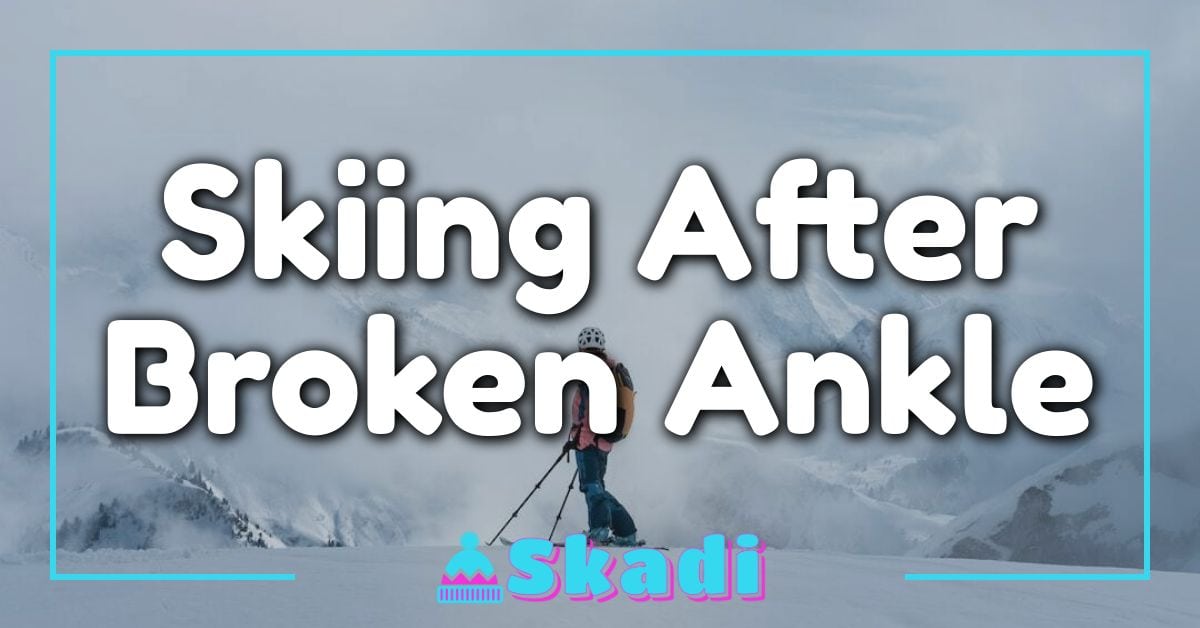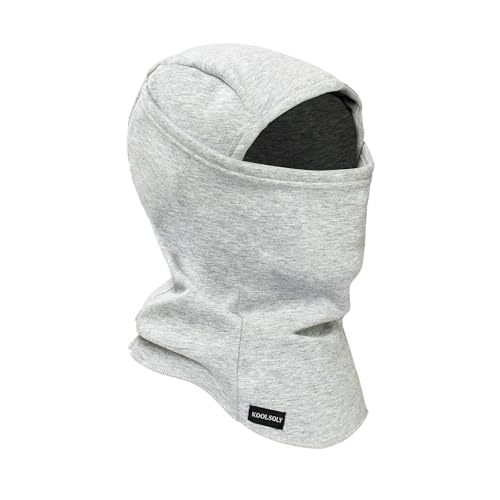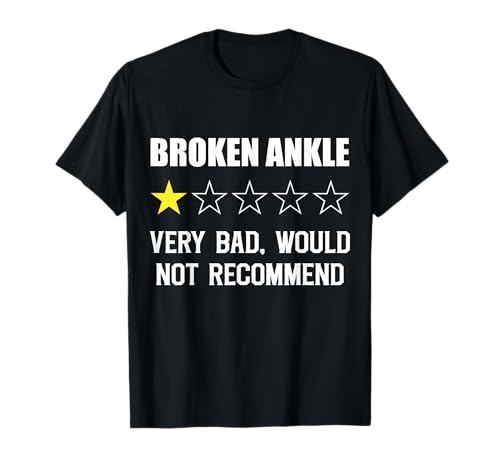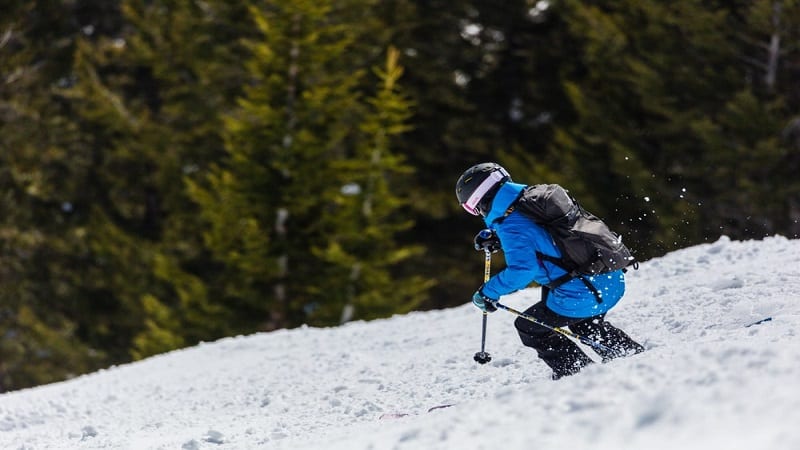You’re probably thinking, “Can I really ski after a broken ankle?” The answer is, yes! It’s definitely possible, but it requires patience and the right approach. Your journey back to the slopes won’t be without its hurdles, but we’ll guide you through some strategies and tips that can help make your return to skiing as smooth as possible.

Your ankle needs time to heal properly before you strap on those skis again. You might be eager to get back out there, but remember that rushing could lead to further injury. So take it easy—make sure your doctor gives you the green light first.
Once you’ve got medical clearance, it’s all about taking things slowly and easing back into your normal skiing routine. Maintain communication with your physical therapist throughout this process; they can give you valuable advice tailored specifically for your recovery progress. After all, who knows better about what your body can handle than a professional? Don’t worry though—with time and perseverance, you’ll conquer those snowy peaks once more!
Understanding Ankle Fractures and Skiing
You’ve got your ski boots laced up, the sun’s gleaming off the fresh powder, and you’re ready to carve your way down the mountain. But then, disaster strikes – a misstep or collision results in a broken ankle. It’s a nightmare scenario for any skier, but it doesn’t mean you have to hang up your poles for good.
Facing an injury like this can be scary. It’s important to understand what an ankle fracture entails before dusting off those skis again. Typically characterized by sharp pain, swelling, bruising or inability to bear weight on the foot, fractures occur when one or more of the bones that make up the ankle joint break. According to statistics from OrthoInfo:
| Type of Injury | Percentage of Sports-related Injuries |
|---|---|
| Sprains & Strains | 41% |
| Fractures | 20% |
Skiing puts quite a strain on your ankles – they absorb shock as you navigate uneven terrain and aid in steering your direction. As such, skiing with an improperly healed fracture risks re-injury or chronic issues down the line.
Recovery time varies depending on the severity of your injury. While minor fractures might only sideline you for six weeks or so, serious breaks could require several months – even years – for complete healing. Medical professionals stress never rushing back into physical activity post-injury.
Once given the green light by your doctor though? You’re free to return to those snowy slopes! Just remember:
- Start slow: Your body needs time to readjust.
- Strengthen: Physiotherapy can help rebuild strength lost during recovery.
- Protect: Always wear appropriate gear (like supportive boots) when skiing.
Remember that getting back on skis after a broken ankle isn’t about proving anything; it’s about enjoying the sport you love. So take your time, listen to your body and most importantly, have fun!
Safe Rehabilitation Exercises After Ankle Break
Hey there, it’s time to talk about the safest exercises you can do post ankle break. It’s all about your recovery journey and getting back on that ski slope!
First things first, don’t rush into any form of exercise without your doctor or physiotherapist’s go-ahead. That being said, here are some pretty safe bets once they give you the green light.
- Ankle Circles: This is a no-brainer! Sit in a comfortable position and slowly rotate your injured ankle in a circular motion – 10 times clockwise then 10 times counterclockwise. Do this at least twice daily.
- Towel Curls: Grab a towel with your toes and try pulling it towards yourself while keeping your heel stable on the ground. You’ll feel those muscles working!
- Calf Raises: Stand next to something solid for support (a wall or chair will do). Raise up onto your tiptoes, hold for a moment, then lower back down.
A key point throughout these exercises is to listen to YOUR body! If you feel pain or discomfort beyond mild soreness, take it easy and let your therapist know.
It’s okay if progress seems slow at first; remember that consistency is KEY during rehab after an injury! Keep up with these exercises daily for steady improvement over time.
Physical therapy does wonders in helping regain strength and mobility after an ankle break but make sure not to overlook another vital component of recovery – nutrition! A diet rich in collagen-boosting foods like bone broth can aid significantly in repairing ligaments and tendons around the injured area.
Remember folks: patience + persistence = successful rehabilitation! Happy healing!
Adapting Ski Techniques Post-Injury
You’ve finally healed from that broken ankle and you’re raring to hit the slopes again! But wait, there’s a few things you might want to consider before strapping on those skis.
First up, remember your body has changed. You’ve spent some time off your feet and your muscles may not be as strong or flexible as they were. It’s important to take it slow, especially in the beginning. Rebuilding strength and confidence is key here.
Secondly, don’t ignore any discomfort or pain. Even if it’s just a nagging twinge, it deserves attention. Listen to what your body is telling you – it knows best!
- Invest in good quality protective gear
- Start with gentle slopes and gradually build up difficulty level
- Consider working with a professional ski instructor initially
Speaking of instructors, enrolling in post-injury skiing classes could be really beneficial for you. With their expertise, they can help tailor your ski techniques to accommodate any lingering weaknesses from the injury.
Lastly, maintain an optimistic yet realistic mindset. Yes, you will get back on those skis! Yes, it might take more time than expected! And yes…it’ll definitely be worth all the effort once you feel that exhilarating rush of air against your face as you carve down the mountainside once again!
In conclusion (but not really!), adapting post-injury doesn’t mean giving up on skiing altogether; rather it’s about adjusting expectations and methods until you’re back up there doing what you love most: shredding powder like nobody’s business!
Choosing the Right Equipment for Skiing with Broken Ankle Recovery
So, you’re on your way towards a successful recovery from that broken ankle and itching to glide down the snowy slopes again? Well, kudos to your spirit! But here’s something important: it’s all about choosing the right equipment. You need gear that’ll support your healing ankle while still allowing you to savor every bit of the skiing experience.
First things first, let’s talk about ski boots. At this point in recovery, your usual pair might not be the best choice. Going for a boot with extra padding around the ankle can provide additional support and comfort. In fact, some manufacturers even offer boots designed specifically for post-injury skiing.
Next up is ski bindings – an often overlooked but crucial piece of equipment. Bindings are what keep you attached to your skis and release during falls to prevent further injury. Look out for bindings with a low DIN setting – this means they will release more easily if you take a tumble.
Your poles are another area where an upgrade could help ease back into skiing after an injury. Opt for ones with adjustable lengths so they can provide balance when needed or be shortened when cruising downhill.
Finally, don’t forget about protection! Helmets are always vital when hitting the slopes but consider investing in padded shorts or knee pads as extra insurance against future injuries.
Here’s a quick recap:
- Ski Boots – Choose ones with additional ankle padding or specially designed post-injury models
- Ski Bindings – Go for options with lower DIN settings
- Poles – Adjustable length poles can offer enhanced balance
- Protection Gear – Helmets are mandatory; consider padded shorts or knee pads as well
Remember folks, being cautious doesn’t mean sacrificing fun! With these tips on hand, we hope you’ll be carving turns in fresh powder sooner than later while keeping that recovering ankle safe and secure.
Psychological Impacts of Returning to Skiing After Injury
Hey there! Let’s take a moment to discuss something often overlooked but extremely important: the psychological impacts of returning to skiing after an injury. It can be a daunting experience, filled with both anticipation and anxiety.
You might find yourself overthinking every move you make on the slopes, worried about reinjuring your ankle. This constant state of worry can actually hinder your performance and recovery process. You may even develop what psychologists call ‘kinesiophobia’, an excessive, irrational fear of physical movement and activity resulting from a feeling of vulnerability to painful injury or re-injury. It’s not uncommon for skiers who’ve had injuries like a broken ankle.
Now imagine this – it’s been months since your accident and you’re standing at the top of the slope again. Your heart is pounding, hands shaking slightly. This isn’t just about physical recovery; it’s also about reclaiming that mental confidence in your abilities.
Let me share some stats with you:
| Percentage | Experience |
|---|---|
| 50% | Skiers face anxiety upon return |
| 30% | Skiers fear re-injury |
These numbers underscore just how prevalent these issues are among athletes returning after an injury.
Here are some strategies that could help ease this transition:
- Visualize success: Visualization techniques have proven beneficial in regaining confidence.
- Take baby steps: Gradually increase difficulty levels instead of jumping right back into challenging runs.
- Seek professional help: A sports psychologist can provide valuable guidance during this period.
Remember, it’s normal to feel anxious when returning to skiing after a broken ankle or any other serious injury. So cut yourself some slack! With time and patience, you’ll be carving down those mountainsides with grace and aplomb once again!
Preventing Re-Injury While Skiing With a Healed Ankle Break
Alright, so you’re back on your feet and itching to hit the slopes after that ankle break. But hold your horses! The key here is not to rush into things. Your enthusiasm is admirable, but let’s remember that preventing re-injury should be your top priority.
First things first, it’s crucial to get clearance from your doctor or physical therapist before you strap on those skis again. They’ll give you the green light when they know for sure your ankle has healed completely. Once you have that approval in hand, let’s talk about what comes next.
Rehabilitation exercises play an essential role in making sure you’re ready for snow sports again. Strength and balance are two main areas to focus on during this process:
- Strength: After a break, it’s common for muscles around the injury site to weaken due to disuse. Specific exercises can help rebuild those muscles and increase joint stability.
- Balance: An often-overlooked aspect of recovery is regaining balance. Balance training helps improve proprioception – which is just fancy speak for how well your body recognizes its position in space.
Now let’s discuss equipment – specifically ski boots. When choosing a boot post-injury, look for one with good support around the ankles and proper fitting to prevent unnecessary strain.
Lastly, consider taking up lessons with a qualified instructor upon returning to skiing post-injury. This isn’t an admission of defeat; it’s an investment in getting back into the swing of things safely!
Remember folks, while we all love the exhilaration of rushing down those snowy slopes, safety should always come first!
Inspiring Stories of Skiers Who Returned After an Ankle Break
It’s not every day you hear about someone bouncing back from a broken ankle to hit the ski slopes again. But, believe it or not, there are some truly inspiring stories out there. Let’s take a peek at a few.
First up is John, a seasoned skier who suffered a nasty break while carving up the mountainside. It could’ve been the end of his skiing days, but John had other ideas. Instead of hanging up his skis for good, he threw himself into physiotherapy with gusto and was back on the slopes just over a year later. His determination serves as proof that it’s possible to return even after such serious injuries.
Next on our list is Sarah – an amateur skier who broke her ankle during what should have been an easy downhill run. Despite this setback, she didn’t let fear get in her way. Through careful rehabilitation and sheer willpower, she was able to strap on her skis again after only six months off!
And then there’s Tom – an aspiring professional when disaster struck on one fateful training session leading to a complex ankle fracture. Many might have called it quits right then and there but not Tom; he made his triumphant return two years post-injury, proving that passion can overcome adversity.
These stories are testament to the fact that with grit and resilience, you can make your way back to doing what you love most – even if that means returning to potentially risky activities like skiing post-ankle break.
Conclusion: Embrace the Slopes Again, Safely and Confidently
Taking up skiing after a broken ankle can feel like quite a mountain to climb. But with patience, determination, and the right preparation, you’ll find yourself gliding down those snowy slopes once again.
Remember, it’s all about taking things slow. Rushing back into action could put you at risk of re-injury or even long term damage. Listen to your body and don’t push yourself too hard too soon.
Make sure you’re fully healed before strapping on those skis. Consult with your doctor regularly to monitor progress and get their approval before hitting the slopes again.
It’s crucial that you properly rehabilitate your ankle – strength training exercises supervised by a physiotherapist can work wonders for this! Not only will these help restore muscle mass around the injured area but they’ll also improve balance which is absolutely necessary for skiing.
Here are some key points:
- Take sufficient healing time
- Regular check-ins with your doctor
- Physiotherapy-guided strength training
Protective gear is another essential part of getting back to skiing after an injury. Invest in high-quality gear that provides ample support without restricting movement too much. And remember, warm-up stretches and cool-down exercises should become part of your daily routine when on a ski trip post-injury.
Finally, approach this as an opportunity to fall in love with skiing all over again. Be patient with yourself while rediscovering the joy of cruising down wintry landscapes blanketed in pristine white snow.
So go ahead! Embrace the slopes again – safely and confidently! You’ve got this!
















